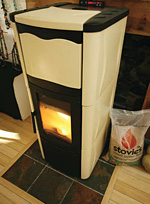Reasons for changing to woodfuel
Before being developed for its present use, the building was
unoccupied and without heating. With no mains gas in the area,
there was a strong impetus to find a financially viable means of
heating the space.
The owners were also keen that the new heating system was
sustainable. Biomass was considered the most suitable option given
the geographic location and interior space.
System features and benefits

The wood pellet boiler is situated in the main café area. To
make it an attractive feature, a model with a
glass door was chosen so that the burning chamber can be seen.
The boiler runs a wet central heating system which includes
domestic hot water and under floor heating. Under
floor heating has several advantages:
- The large radiating area allows efficient heat retention
- Pipe work can have a lifespan of up to 100 years
- Under floor heating loops are practically maintenance-free if
installed without any joints
- Energy savings of up to 40% can be achieved over traditional
radiators
The small internal pellet store holds 1-2 days
of pellets allowing the boiler to be positioned in rooms with
limited space.
The performance of the system has been good and the owners are
very satisfied. Key benefits are:
- Very economical solution for off gas mains areas
- Carbon lean technology preferred by owners
- Clean and easy fuel to handle
- Added value to customers and visitors
Wood fuel supply
The first deliveries of pellets came from Argentina and Ireland
but the café now has a secure, local supply of good quality
pellets.
Installation issues
The heating system was part of a larger process of building
development with the only significant structural change being the
provision of a flue. Consequently planning constraints were
minimal.
Lessons learned
- Seek local fuel supply to maximise carbon savings
- Installation and ongoing service package should be arranged
together
- Using an experienced wood fuel installer will help guarantee a
good installation
- If repeating the project Cloud House Cafe would have installed
radiators, since they find that when it is very cold it takes a
long time for the Cafe to heat up through the floor
Facts and figures
Note from editor: When this woodfuel system was
installed, the UK Government Renewable Heat Incentive (RHI) scheme
did not exist. The RHI is now available and commercial woodfuel
heating installations can receive payments based on metered heat
produced for 20 years.
If this project were eligible for the RHI, it could
generate up to £1,860 of income per year, based on the maximum
biomass tariff of £0.086 per kWh, assuming the boiler is run at
maximum capacity for 800 hours of the year, this income could be
combined with any savings made over displacing fossil fuels to give
a potentially very attractive payback period.
Projects installed pre July 2009, or that have received public
grants for their boilers from other sources (unless they have paid
them back) are not eligible for the RHI
Note: figures above and below are approximate
| Building |
| Heated area |
60 m2 |
| Heated volume |
145 m3 |
| Fabric |
16th century stone |
| Heating system |
| Boiler manufacturer/model |
Lucrezia Idro |
| Maximum boiler output |
27 kW |
| Fuel type |
Wood pellets |
| Fuel specification |
Moisture content: <10% (M10) |
| Store capacity |
1-2 days 0.045 tonnes (0.03 m3) |
| Back-up/top-up system |
Accumulator tank (700 litres) |
| Fuel consumption and cost |
| Annual wood fuel use |
4.5 tonnes |
| Wood fuel cost |
£1,000 per annum |
| Installation cost and funding |
| Boiler system |
£7,600 |
| Funding source |
Scottish Biomass Heat Scheme |
| Funding support rate |
50% of additional costs of woodfuel system |
Please note: